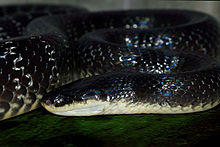| Sind krait | |
|---|---|
 | |
| Scientific classification | |
| Kingdom: | Animalia |
| Phylum: | Chordata |
| Class: | Reptilia |
| Order: | Squamata |
| Suborder: | Serpentes |
| Family: | Elapidae |
| Genus: | Bungarus |
| Species: | B. sindanus |
| Binomial name | |
| Bungarus sindanus Boulenger, 1897 | |
| Synonyms[1] | |
| |
Bungarus sindanus, the Sind krait, is a species of krait, a venomous elapid snake found in India, Iran, Bangladesh, Nepal, and Pakistan. Three subspecies are recognized. It can be confused with the common krait and even with the Indian rat snake.
Description
The Sind krait is generally 1 m (3 ft) with some specimens as long as 1.8 m (6 ft). Their most visible feature is their narrow white bands, though the bands can be either yellow or grey depending on the color variation. The young have white spots on one-third of their body instead of bands (which develop at maturity). They have an egg-shaped head with a short snout, small eyes, upper lips either yellow or white and pointed tip tail.[2]Dorsal scales are smooth and glossy with the vertebral row enlarged and hexagonal. Dorsal scale count 19 ( 21 ) - 17 ( 19 ) - 17.
Behavior
Sind kraits are nocturnal & often get close to humans .[3][2] They are responsible for 40% of krait bites in Bangladesh
Distribution and habitat
Bungarus sindanus is found in India, Nepal, and Pakistan. It is recorded in Uttar Pradesh, Bihar, Maharashtra, West Bengal (Jalpaiguri and Midnapur District), Rajasthan, and Gujarat in India. The geographic ranges of the subspecies are:
- Bungarus sindanus razai Khan, 1985 - north Pakistan
- Bungarus sindanus sindanus Boulenger, 1897 - southern Pakistan, adjacent India; type locality: Sindh, West Pakistan
Etymology
The subspecific name, walli, is in honor of British herpetologist Frank Wall, who named the taxon after himself, admitting that it was a "breach of ethics" to do so.[4][5]
References
- ^ "Bungarus sindanus ". The Reptile Database. Reptile-database.org.
- ^ a b "Snakes of Pakistan: Common Krait, Sindhi Krait, Northern Punjab Krait". Wildlifeofpakistan.com. Retrieved 13 November 2017.
- ^ "About SHE". She-india.org. Retrieved 13 November 2017.
- ^ Beolens, Bo; Watkins, Michael; Grayson, Michael (2011). The Eponym Dictionary of Reptiles. Baltimore: Johns Hopkins University Press. xiii + 296 pp. ISBN 978-1-4214-0135-5. (Bungarus sindanus walli, p. 79).
- ^ Wall (1907).
Further reading
- Boulenger GA (1897). "A new krait from Sind (Bungarus sindanus)". J. Bombay Nat. Hist. Soc. 11: 73–74.
- Kuch, Ulrich (2004). Bungarus sindanus Boulenger, 1897, an addition to the venomous snake fauna of Afghanistan". Herpetozoa 16 (3/4): 171–173.
- Vyas, Raju (1998). "Unusual marking pattern in krait Bungarus sindanus ". Cobra 32: 34–35.
- Wall F (1907). "A new krait from Oudh (Bungarus walli)". J. Bombay Nat. Hist. Soc. 17: 155–157.
External links